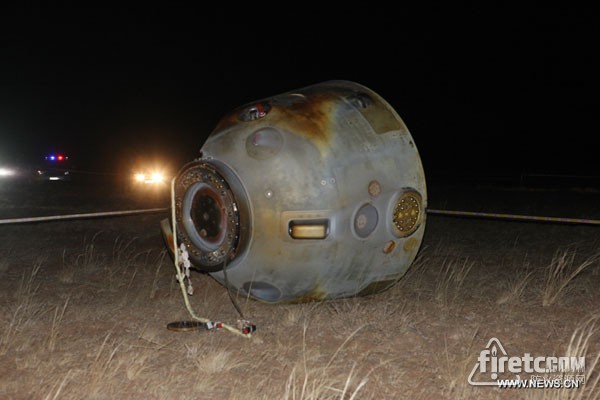China wrapped up its first-ever space docking mission Thursday upon return of the unmanned spacecraft Shenzhou-8, leaping towards the nation's ambition of building a permanent manned space station in around 2020.
Shenzhou-8, aided in the air by a parachute, landed in Siziwang Banner (county) in north
Chang Wanquan, commander-in-chief of the manned space program, announced at the Beijing Aerospace Control Center (BACC) that the space docking mission was a "complete success."
"The whole procedure of space docking -- from the launches of both Tiangong-1 and Shenzhou-8 into orbits, the two docking tests, to Shenzhou-8 return -- was flawless," said Zhou Jianping, chief designer of the manned space program.
"We have not only made a breakthrough in space docking technologies, but also validated the capability of the rocket, the spacecraft as well as the whole system, laying a solid foundation for the building of a space station," Zhou said at the BACC after watching the return of Shenzhou-8.
"Technically, I would give the mission full marks," he said.
Shortly after the landing, Vice Premier Zhang Dejiang, who also observed the return of Shenzhou-8 at the BACC, delivered a congratulatory note issued by the central authorities.
The successful rendezvous and docking between the target orbiter Tiangong-1 and the Shenzhou-8 spacecraft marks a significant breakthrough in
It is an important milestone in the history of
Launched from the
Tiangong-1, which blasted off from the same launch site on Sept. 29, will remain in orbit to await docking attempts of both Shenzhou-9 and Shenzhou-10 in 2012. At least one of the two space vessels will take astronauts.
Three-phase manned program
After Chinese astronauts made successful extravehicular activities during the Shenzhou-7 mission in 2008,
After the planned Shenzhou-9 and Shenzhou-10 missions both in 2012,
In the third stage,
The assembly of the China-made space station will come at a time when the International Space Station (ISS), which was jointly initiated by the
Chief designer Zhou said
"The Chinese space exploration will benefit well-being of all humanity," Zhou said.
Independent, economical and reliable program
"The theory of space docking is not hard to understand, but realization of the procedures is extremely complex," Zhou said.
"All the technologies and products on space docking were developed independently by ourselves," he said. "Nothing was bought from others."
Zhou said
Compared with space dockings of the United States and Russia, the cost-effective Chinese way features multiple docking with the same target orbiter Tiangong-1, which is scheduled to link to Shenzhou-8, Shenzhou-9 and Shenzhou-10 respectively.
"
Following the principle of "get more done on less money,"
In contrast, the US National Aeronautics and Space Administration (NASA) has an annual budget of US$17 to US$18 billion.
"
"We prioritize reliability and safety while maintaining fast development, though we have also been set back by failures," he said.
Zhou, however, noted that
The world's mainstream rockets have the thrust capacity of 20 tonnes, which
To prepare for the building of

The re-entry capsule of Shenzhou-8 spacecraft is found at a landing site located in Siziwang Banner in north


